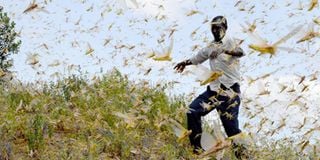Breaking: Autopsy reveals how Cyrus Jirongo died
Premium
FAO: Kenya staring at another wave of locusts invasion

What you need to know:
- Kenya is just recovering from the worst infestation in 70 years and the worst outbreak in 25 years for neighbouring countries of Somalia and Ethiopia.
In Samburu, disaster management teams have sprayed about 1,000 hectares of land in Samburu West where the survivors of the pests had infested.
Kenya is staring at another wave of desert locusts’ invasion, as fresh swarms migrate to northern Kenya from Somalia, Ethiopia and Eritrea.
United Nations’ Food and Agriculture Organization, FAO has warned that the swarms could be entering Kenya, just a few months after it had alluded that the country is almost winning the war against the plague.
Kenya is just recovering from the worst infestation in 70 years and the worst outbreak in 25 years for neighbouring countries of Somalia and Ethiopia.
But FAO's latest report dated October 5 says wind-blown swarm migration from Yemen could again plague Ethiopia, Somalia in October and extend to Kenya in November.
The fast-moving insects were first sighted in Wajir County and later in Mandera, Marsabit, Garissa, Isiolo, Samburu, Meru and Laikipia. They later spread to close to 29 counties in Kenya where they left a trail of destruction.
Migration
“As winds from the north become established over the Horn of Africa, there will be an increased threat of swarm migration from Yemen, northeast Ethiopia and northern Somalia south to eastern Ethiopia and central Somalia in October and that could extend to northern Kenya in November,” the FAO report noted.
Locusts can travel about 90 miles a day and eat their own body weight in crops, thus making them fast moving especially during heavy winds.
Though ground and aerial controls continue in the Horn of Africa and Yemen, FAO says the situation is worrying and could deteriorate during October because of recent breeding.
The report shows that there is substantial hatching and hopper band formation which has caused numerous immature swarms to form in northeast Ethiopia. “An increasing number of swarms has been reported in northern Somalia, including cross-border movements between northwest Somalia and eastern Ethiopia,” said the report.
Invasion of the pests disrupted grazing patterns and nomadism in northern Kenya, prompting acute hunger and other unprecedented effects to the communities living in the region. When the voracious pests landed, they destroyed crops and grazing vegetation covers in pastoralism areas.
Disaster management
In Samburu, disaster management teams have sprayed about 1,000 hectares of land in Samburu West where the survivors of the pests had infested.
Samburu County special programmes Chief Officer Daniel Lesaigor told the Nation that they have killed three swarms that crossed over from Turkana.
"There are very few survivors remaining and we are still doing aerial surveillance across the county and we have aircrafts for aerial spray in case we spot swarms," Mr Lesaigor said.
He noted that invasion of desert locusts has left a trail of destruction in Samburu, particularly worsening food insecurity by destroying pastures for livestock in parts of the county that were hard hit by the invasion.
"Samburu communities will be food insecure due to the damage caused by the locusts on food as well as pastures for livestock," he said.
Climate change
Climate change has played a major role in creating a conducive environment for desert locusts to breed and thrive. For instance, in the last 12 months, Samburu experienced above average rains and floods, making the sandy soils to become unusually moist. These conditions turned to be perfect for female locusts to lay eggs and breed.
Mr Lesaigor noted that most swarms that are spotted in the region have are about to mature and could start breeding if torrential rains are witnessed in the coming weeks.
He said disaster management teams are on high alert and are monitoring the situation on the ground should they record a new wave of invasion.
Aerial spraying is the only effective means of controlling the destructive pests but there have been complaints that the pesticides are affecting livestock in the northern Kenya where pastoralism is majorly practised.
FAO estimates that up to 20 million people living in Ethiopia, Kenya and Somalia could be affected by food insecurity posed by the swarms whose numbers are projected to increase amid ongoing breeding in the horn of Africa.





